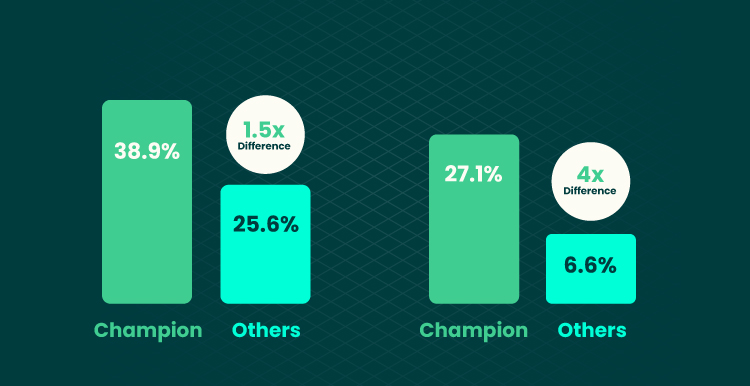In the era of digital transformation, companies need to adapt to new challenges throughout their business lifecycles to enhance revenue growth and ensure profitable ROI.
In comparison with an age-old siloed approach toward business running, cross-functional collaboration empowers business functions to reduce competitive threats. This type of cooperation drives value by leveraging digitization efforts. Indeed. According to the survey conducted by Accenture in 2020 among 1,550 C-level executives, the cross-functional impact of digital transformation investments brought them four times higher revenue as opposed to their peers: 27 percent compared with 6.6 percent.

Amid rising COVID-19 large-scale economic destabilization in the last years, companies were able to utilize this opportunity and strengthen their potential toward iterative innovation and inter-functional experimentation. Let’s go further to shed light on the specifics of cross-functional collaboration within a company, its benefits, and its downsides. Stay with us to learn what makes this approach stand out in the crowd and how to achieve tangible results while leveraging cross-functional strategies.
What Is a Cross-Functional Team and Why Do You Need This Approach?
Cross-functional teams are based on the Agile approach involving members versatile in their expertise to collaborate to achieve one common goal. As opposed to the traditional top-to-bottom hierarchy where employees need to report their activities to the line manager and be dependent on the decision-making of one person in charge, cross-functional collaboration allows for a much more self-organized environment where team members from various departments play their special role in pursuing the common company’s objective.
With autonomous behaviors within the team environment, each member invests their unique skill sets and fresh perspectives. They deliver novel business outcomes and make the business process resilient and capable of ensuring fast decision-making.
Let’s outline the main advantages of cross-functional collaboration you can reap to drive profitable revenues:
Efficiency improvement to boost fulfillment
Let’s imagine you are going to release your product to your target audience and your sales team has to elaborate upon the strategy of how to push it properly to the market. Combining efforts and backgrounds from different departments facilitates seamless product delivery without the need to be stuck during the process of figuring out challenges occurring on the pathway.
Therefore, working alongside the product team and marketing team, sales representatives eliminate threats of downtime and build their sales funnels aligned with the current product development and marketing campaigns. Leveraging several practices from different departments, the team’s workflow becomes agile, allowing it to be more productive and connected and fostering faster problem-solving.
Innovation promotes ideation
There are no siloed structures in the cross-functional approaches since the processes and connections are not limited to separate goals. Everyone is engaged in the group-thinking status quo where all fresh insights and ideas flow in to accelerate ideation concepts in a fast and progressive manner.
Cross-functional team motivation prevents customer frustration
To be customer-centric and deliver a great customer experience, it is significant to ensure a holistic customer lifecycle, spanning from prospect to buyer. With scattered data siloes that lack interoperability, it’s hard to achieve better results. For instance, if your development team does not collaborate with the customer support team permanently, they will be not able to fix bugs once the malfunction happens. There will be delays that can result in customers’ frustration.
Taking into consideration that millennials tend to prefer swift resolutions, personalization, and innovative solutions, businesses need to be on-trend and follow novel tendencies to adapt to fast-paced customer experiences. To deliver results at the speed that the customers expect, different team members should be involved to interact with users directly without the need to wait for the “big man” approval.
Fewer execution breakdowns help achieve higher business outcomes
Without cooperation, teams within a company deal with inefficient resource allocation, which leads to constraints on problem-solving and decision-making. When you have a holistic view of all the workflows and contribute to each project lifecycle, you facilitate the acceleration of the whole project eliminating the unintended wastes of time and money.
What Are the Challenges of Cross-functional Teams?
Even if the cross-functional collaboration works great in most cases and is positioned as a driver for higher business performance and revenue growth, it still isn’t a silver bullet to efficiency issues. In the study conducted among 95 teams, 75 percent of cross-functional teams turned out to be dysfunctional. But it doesn’t mean that this collaboration is inclined to be a fiasco. There are a set of factors that can hinder the systematic approach aimed at delivering high-level results:
- The absence of government support or a high-level executive champion;
- Non-compliance with the schedule;
- Overestimated budget planning;
- Nonalignment with the organization’s goals;
- Bad visualizing and managing dependencies.
Start Developing Cross-Functional Team: Tips, Strategies, Recommendations to Follow
To get the most out of your cross-functional team, we propose to weigh all the pros and cons of such a collaboration style and outline the main challenges you can meet during the implementation. With that in mind, follow this roadmap to overcome perception gaps that can still be standing in the way.
1. Clearly define the goal.
This is the decisive measure before you proceed with assembling the team. Without a well-elaborated and clear vision and mission, the collaboration will only harm your strategy. Therefore, it’s crucial to define objectives and craft a step-by-step strategy aligned to them. To foster smooth team coordination that will help achieve the project’s objectives, precise deadlines, and milestones need to be established. Answer the following questions:
- What is the timeline of the project?
- How is your team going to reach all of the objectives simultaneously with other current business functions?
- What are the outcomes your team wants to achieve?
- What budget is needed to complete the goals?
- What criteria will you follow to estimate the project’s success?
2. Define roles and responsibilities (remember about the mutual goal).
Once you defined the objective, you have to identify the strengths and weaknesses of your team members to define roles and responsibilities. At the same time, it’s imperative to consider the fact that cross-functional teams are geared at respecting each member and establishing their authority despite their technical expertise or someone’s better soft skills or decision-making traits.
Having identified the skill set of each team member involved, you (as a leader) can organically combine them to achieve a holistic view of the workflow. Mind that the substantial pillar of cross-functional collaboration is diversity. This means that each team member is highly appreciated since he/she can be an integral cog in the machine.
3. Identify leadership hierarchy.
Selecting the right leader is also a must-have requirement. This person needs to be in charge of regular organizational needs and contribute to the whole project’s success. A great leader is equipped with the following traits:
- Knows how to overcome potential communication barriers;
- Defines crystal-clear goals on an individual level to prevent misunderstandings;
- Pays individual attention to each team member;
- Facilitates an innovative environment where the ideas of each player in the team will be manifested.
4. Establish a favorable team climate.
To disclose the communication strategy your team must align to, we will break it down into the following categories:
Define guidelines for collaboration
Here we talk about how the working processes and agenda are organized. There are no siloed approaches toward your team meeting operation and adhering to agreements. Therefore, it is of high priority to discuss and establish guidelines for your working regime, decision-making processes, etc.
Siloing is the core issue that needs to be overcome through transparency and complete visibility. Once you define the precise requirements of collaborative communication, you will be speaking the same language and being on the same page with all team members.
Encourage quality communication
With a properly elaborated communication strategy (scheduling regular meetings, creating the shared internal documentary, diversifying communication channels, etc.), you are equipped with an effective communication protocol each member will use to achieve the same goal.
To coordinate the information flow across the team, it is essential to break the communication barriers by leveraging communication platforms and tools. With such tools as Jira, Asana, and Trello, your team will be interconnected and always available wherever they are. In Slack, for example, you get versatile opportunities to optimize and streamline cross-team communication.
Incentivize healthy conflict resolution
According to the study, 85% of employees experience conflicts. Being traditionally siloed, cross-functional teams are prone to conflicts and misunderstandings, which often means that people strive for growth and development. Therefore, team leaders have to be able to embrace differences in opinions and adjust the conflict to get a beneficial resolution.
5. Have regular check-ins to keep the team on track
Permanent communication between all the members of the project is a must-do practice to prevent confusion and misconceptions. Regular meetings can help keep all the team players on track and ensure that the collaboration is in sync. We recommend creating a separate agenda to discuss in detail the team’s updates and brainstorm new ideas.
Before the meetings, each member has to write down all the updates to consistently and seamlessly set up the planned online event, which will help maintain the shared understanding of the key business metrics and keep track of accountability. Consider that these check-ins must be aimed at summarising the work done, project status, and reporting team’s updates, not for a detailed discussion of the issues that occur on the way. Following a clear agenda will help your team estimate the work done and streamline the decision-making process.
What Platform to Choose for Cross-Functional Team: Essential Features
So now, you understand how to manage cross-functional collaboration and that leveraging the technology will benefit your ultimate efforts. There are plenty of various project management tools and platforms for your consideration. However, we decided not to list them here but to define the key features that are worth considering before purchasing one.
Data Accessibility
With simplified data and streamlined workflows, your team gets a holistic view of all the project details that will be easy to share with all related stakeholders. By data accessibility, we mean that a tool has to contain reporting features and dashboard visualization. Instead of producing reports manually, reporting features allow team members to automatically generate insightful reports to make accurate anticipation of possible scenarios.
With customizable visualization dashboards, you can utilize your preferences while representing data and metrics from the reports that you prefer in a user-friendly and accessible manner.
Task Management
For you to efficiently manage the project, you need a tool to systemize and categorize your tasks into manageable parts corresponding to a certain aspect of the project management: file sharing, email alerts, schedules, calendars, etc. Task management features allow you to order the tasks in sequence with the opportunity to assign them to other team members and add target completion dates. Also, you should be able to prioritize the tasks and indicate the start date of the project and the number of days required for its completion so that the scheduling feature can automatically calculate the end date and notify each member of these details.
For Agile advocates, the project is divided into milestones indicating the beginning of the next stages. Namely, adaptive planning, iterative delivery, continuous enhancement, iterative backlog management, sprints, reflection, deliverables, phases in sequential order, etc. are the features that your tool should cover.
But not all at once, of course! It depends on the type of methodology you will select for your project, whether it is Waterfall, Agile, Kanban, or Scrum. Contact our experts to learn more about each of the methodologies.
There are such top Agile project management tools available for 2022: Jira, Asana, Trello, Monday.com, ClickUp, Smartsheet, and more.
Integration
Being a single point of access, your project management tool should be able to be integrated with your legacy systems to eliminate redundant loggings into separate platforms without synchronization. So when selecting your cross-functional collaboration tool, pay attention to the possibility of seamlessly integrating it with third-party providers for inventory, accounting, or HR purposes (Gmail, Slack, Google Docs, CRM, or ERP systems). So that, you can get accurate calculations of the logistics processes, for instance, by inserting them into your project management system for further processing of these data. Then, you will be able to obtain insights for forecasting future scenarios for your sales team. Moreover, seamless integration allows for eliminating double-entry data that is likely to be prone to errors.
What’s Next?
It may seem that setting up a cross-functional collaboration within your company cannot be a win-win solution for you or needs a lot of effort to make shifts. However, you need to try out this approach if your team tends to follow a conventional hierarchical structure. The thing is that cross-functional models are agile and adaptive to new changes. What’s great, you can move to this type of team structure gradually, by evaluating and refining the processes accordingly. If you are still on the path toward digital transformation, we can help streamline and optimize this process – just let us know.
There is a great alternative for you in case you would like to hire an expertized dedicated team if you have tight deadlines, or maybe you aim at scaling and are seeking for cross-functional collaboration model for your team. Contact us for more details.









